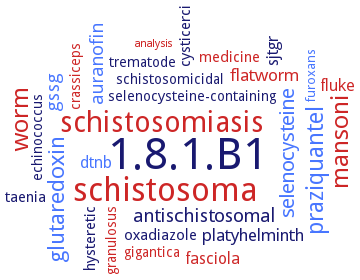1.8.1.B1: thioredoxin glutathione reductase
This is an abbreviated version!
For detailed information about thioredoxin glutathione reductase, go to the full flat file.

Word Map on EC 1.8.1.B1 
-
1.8.1.B1
-
schistosoma
-
schistosomiasis
-
worm
-
mansoni
-
praziquantel
-
glutaredoxin
-
selenocysteine
-
antischistosomal
-
gssg
-
auranofin
-
platyhelminth
-
flatworm
-
dtnb
-
fluke
-
sjtgr
-
fasciola
-
oxadiazole
-
cysticerci
-
hysteretic
-
medicine
-
taenia
-
trematode
-
echinococcus
-
granulosus
-
schistosomicidal
-
crassiceps
-
gigantica
-
selenocysteine-containing
-
furoxans
-
analysis
- 1.8.1.B1
- schistosoma
- schistosomiasis
- worm
- mansoni
- praziquantel
- glutaredoxin
- selenocysteine
-
antischistosomal
- gssg
- auranofin
-
platyhelminth
- flatworm
- dtnb
- fluke
-
sjtgr
- fasciola
-
oxadiazole
- cysticerci
-
hysteretic
- medicine
-
taenia
-
trematode
-
echinococcus
- granulosus
-
schistosomicidal
- crassiceps
- gigantica
-
selenocysteine-containing
- furoxans
- analysis
Reaction
Synonyms
cTGR, DmTrxR, EgTGR, mTGR, SmTGR, TGR, TGRsec, thioredoxin glutathione reductase, thioredoxin-glutathione reductase, thioredoxin/glutathione reductase
ECTree
Advanced search results
Engineering
Engineering on EC 1.8.1.B1 - thioredoxin glutathione reductase
Please wait a moment until all data is loaded. This message will disappear when all data is loaded.
H464Q
-
mutant enzyme has only 2% of the wild-type activity. The pH dependence of Vmax for wild-type DmTrxR has pKa values of 6.4 and 9.3 on the DmTrxR-DmTrx-2 complex, whereas H464Q DmTrxR only has an observable pKa at 6.4, indicating that the pKa at pH 9.3 is contributed mainly by His464. The pKa at pH 6.4 is assigned to Cys57 and Cys490. The thiolate on Cys490 is the nucleophile in the reduction of Trx. In contrast to wild-type DmTrxR, H464Q DmTrxR does not stabilize a thiolate-FAD charge-transfer complex in the presence of excess NADPH. The rates of steps in both the reductive and the oxidative half-reactions are markedly diminished in H464Q DmTrxR as compared to those of wild-type enzyme, indicating that His464 is involved in both half-reactions
C31S
-
the mutant has negligible deglutathionylase and GR activities when compared with wild type enzyme
C34S
-
both the deglutathionylase and GR activities of the mutant are only slightly lower when compared with wild type enzyme
C519S
C573S
the selenium content of wild-type enzyme and the C574S mutant enzyme is 17% and 15%, respectively
C574S
-
about 30% of wild-type activity with both substrates glutathione and 5,5'-dithio-bis(2-nitrobenzoic acid)
R451A
-
mutation mutation led to the decreased stability of the protein. Mutation significantly decreases both oxidoreductase activities (glutathione reductase and thioredoxin reductase) of the enzyme
U642C
in the wild-type enzyme, the KM value for NADPH is significantly higher than in the mutant enzyme, whereas the KM value for the oxidizing substrate thioredoxin disulfide in the wild-type enzyme is significantly lower than the Km-value of the mutant enzyme
C28A
-
compared to the wild type enzyme, the mutant shows 38% activity with 5,5'-dithiobis(2-nitrobenzoic acid), 4% activity with GSSG, and 74% activity with thioredoxin disulfide
C28A/C31A
-
compared to the wild type enzyme, the mutant shows 50% activity with 5,5'-dithiobis(2-nitrobenzoic acid), 3% activity with GSSG, and 79% activity with thioredoxin disulfide
C31A
-
compared to the wild type enzyme, the mutant shows 38% activity with 5,5'-dithiobis(2-nitrobenzoic acid), 18% activity with GSSG, and 100% activity with thioredoxin disulfide
C31S
-
compared to the wild type enzyme, the mutant shows 100% activity with 5,5'-dithiobis(2-nitrobenzoic acid), 129% activity with GSSG, and 105% activity with thioredoxin disulfide
C520A
-
compared to the wild type enzyme, the mutant shows 31% activity with 5,5'-dithiobis(2-nitrobenzoic acid), 26% activity with GSSG, and 47% activity with thioredoxin disulfide
C520A/C574A
-
compared to the wild type enzyme, the mutant shows 38% activity with 5,5'-dithiobis(2-nitrobenzoic acid), 26% activity with GSSG, and 42% activity with thioredoxin disulfide
C574A
-
compared to the wild type enzyme, the mutant shows 38% activity with 5,5'-dithiobis(2-nitrobenzoic acid), 37% activity with GSSG, and 42% activity with thioredoxin disulfide
E330A/D334A
mutation of two key residues interacting with the inhibitor 4-aminopiazthiole. Inhibition at 0.5 mM 4-aminopiazthiole is indistinguishable from that of the wild type enzyme
E337A
mutation of E337 an interacting residue of the inhibitor indole-3-carbinol, Inhibition at 0.5 mM indole-3-carbinol is indistinguishable from that of the wild type enzyme
U597C
additional information
-
analysis of TGR mutants reveales that the glutaredoxin domain is required for the glutathione reductase activity but does not affect the thioredoxin reductase activity. In contrast, both glutathione reductase and thioredoxin reductase activities are dependent on the Sec-containing redox center. The activity loss caused by the Sec-to-Cys mutation can be partially compensated by a Cys-to-Sec mutation of the neighboring residue, indicating that Sec can support catalysis at this alternative position
-
about 30% of wild-type activity with both substrates glutathione and 5,5'-dithio-bis(2-nitrobenzoic acid)
C519S
the selenium content of wild-type enzyme and the C519S mutant enzyme is 17% and 15%, respectively
-
compared to the wild type enzyme, the mutant shows 25% activity with 5,5'-dithiobis(2-nitrobenzoic acid), 21% activity with GSSG, and 18% activity with thioredoxin disulfide
U597C
the mutant displays significantly decreased enzyme activities compared to the wild type enzyme


 results (
results ( results (
results ( top
top






